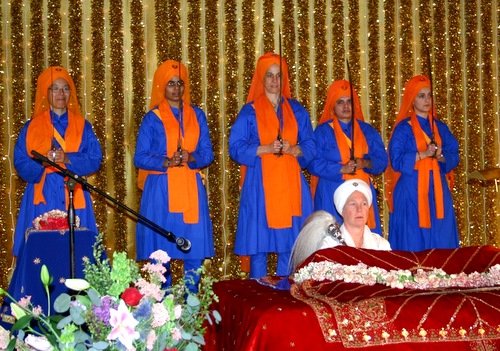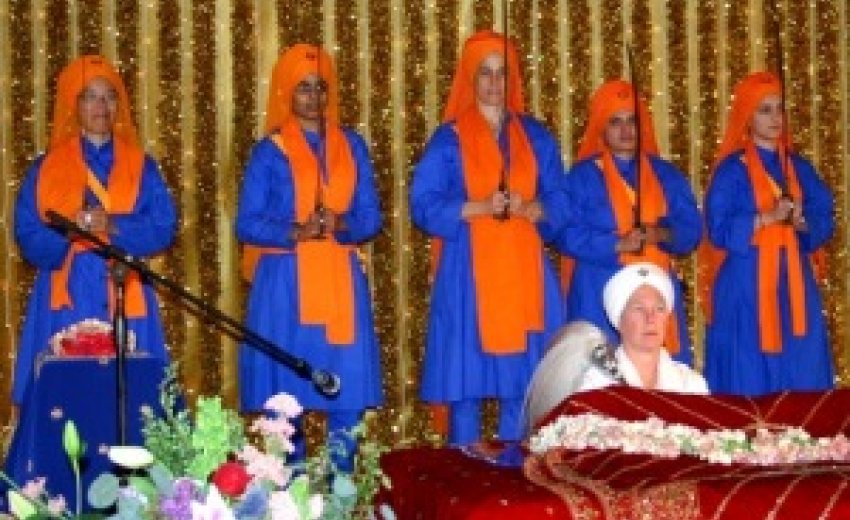
The Khalsa represents the spirit of humankind in its pristine form. This is the spirit the creator gave when humans were created. It is immaculate, pure, unadulterated and in direct communication with "Sat Kartar", the Creator. The Tenth defined the Khalsa thus:
Jaagat jot japai nis baasur ek binaa man naik na aanai|;
Pooran prem prteet sajai brat gor marhi mat bhool na maanai||
Teerath daan dayaa tap sanjam ek binaa nah ek pachhaadai||
Pooran jot jagai ghat mai tab khaalas taah(i) nakhaalas jaanai||1||
One who remembers the ever-lit Lamp (The light, Akal Purakh) night and day, and brings none else to mind;
Practices this with perfect devotion and love, does not make the mistake of worshiping at tombs or mausoleums.
Does not believe in pilgrimages, charities, penances and austerities.
Recognizes none but the One Akal Purakh.
One whose mind is illuminated by such perfect light is recognized as a perfect Khalsa.
The Tenth Guru gives two types of attributes for the Khalsa, namely faith in one Akal Purakh and rejection of rituals like pilgrimages. The word Khalsa accordingly has two interconnected meanings - first, purity of faith in one God, and second, freedom from the bondage of rituals or other means of worship. So, a Khalsa's life is characterized by freedom with obedience. This makes the Khalsa fearless.
The concept of unity of belief is well understood amongst the Sikhs. Let us see the aspect of freedom from bondage. Those who perform rituals seem to get the satisfaction of having done something tangible spiritually. However they remain caught in these and cannot advance on the path to God. The Third Guru explains that all types of bondages are due to illusions which are caused by ignorance:
mmqw mohu su bMDnw puqR klqR su DMDu ]
jh dyKw qh jyvrI mwieAw kw snbMDu ]
nwnk scy nwm ibnu vrqix vrqY AMDu ]1]
Jah daykha tah javri maaiaa ka sanbandhr;
Nanak sachay naam binu vartan vartai andhu. 1. (M: 3, SGGS, p 551).
Rituals are bondages because of belief in superstitions about "Paap Nad Punn" (Good and bad deeds);
Possessiveness is bondage because of attachment to the spouse and the children;
This bondage may be seen every where; it is Maaiaa, the world play.
People act in ignorance; this happens due lack of earning Divine virtues.
The dual concept of belief in one God and liberation from bondages was not anything new but only a restatement of what Gurbani says:
AsiQru kry inhclu iehu mnUAw bhuir n kqhU DwvY ]1]
hY koaU AYso hmrw mIqu ]
sgl smgRI jIau hIau dyau Arpau Apno cIqu ]1] rhwau ]
Hai kouoo aiso hamra meetu;
Sagal samagree jeeo heeo dayau arpau apno cheet.1. Pause. (M: 5, SGGS, p 674).
Is there a friend of mine?
Who can liberate me from bondage; enable me to meet Akal Purakh through remembering Divine virtues;
stabilize my mind such that it wavers no more, never to run elsewhere. 1.
I shall offer all my wealth, life and mind and dedicate my thoughts to such a friend.
Whereas creation of the Khalsa, the saint soldiers, changed the course of history in South Asia many non-Sikh writers and speakers call this an aberration to the path shown by Guru Nanak, the founder of the Sikh faith. This is not so. On the contrary, Guru Nanak advocated practicing faith with a commitment even to die. He says:
iequ mwrig pYru DrIjY ] isru dIjY kwix n kIjY ]20]
Itu maarag pair dhareejai; siru deejay kaani na keejai. 20 (Slok Vaaraan tay Vadheek. SGGS, p 1412).
If you want to play the game of love; come prepared to sacrifice your life;
Once you step on this path; do not hesitate to make the supreme sacrifice.
The Sikh faith is a mansion that has grown with time. It has a strong and unshakable foundation that was laid by Guru Nanak and has grown with the blessings of the Almighty says the Fifth Guru:
Aibcl nIv DrI gur nwnk inq inq cVY svweI ]2]15]24]
Angeekaaru keeo mayrai kartai gur pooray kee vadiaaee;
The unshakable foundation laid by Guru Nanak has been built on and grown magnificently.
Creation of the order of the Khalsa on the Baisakhi of 1699 CE was the culmination of this process and provided the pinnacle of the mansion. The Guru had sent messages to the Sangat or local assemblies, to congregate in large numbers at Anandpur Sahib that day. He came to the assembly with an unsheathed Kirpan and asked for five heads. Five brave Sikhs, Panj Pyaray or the five loved ones of the Guru came forward. This was high drama and an example of effective communication skills asking people to know that the Khalsa was to be ever ready to make the supreme sacrifice if circumstances demanded. He prepared and administered "Amrit", the immortalizing ambrosia to the five Sikhs and they became "Singhs" or lions. The Guru then asked the five to administer "Amrit" to Him. The Guru thus also became the disciple; Guru Gobind Rai became Guru Gobind Singh.
This was not new. The practice of the Guru bowing to the disciple was introduced by Guru Nanak when, while bestowing Guru-ship to his successor, Bhai Lehna and made him Guru Angad. This continued down the line.
It would be noticed that the Tenth Guru went according to the already existing teachings of the Sikh faith. The examples of willingness to die for a cause, combination of belief in God with rejection of rituals and the Guru also becoming the disciple, already existed. He did not introduce anything radically different. Even recourse to arms was on the lines of what the Sixth Guru had done.
A Khalsa is ever conscious that he/ she owes his/ her existence to Akal Purakh, the Timeless and Deathless Creator. The Khalsa also works as the soldier of the Creator and is at once a saint and a soldier, a saint-soldier - "Sant-Sipahi". We read in Sarab Loh Granth:
??????? ????? ?????? ?? ??? ?
"Khalsa Akal Purakhki fauj.
Pragtio Khalsa Parmatam ki mauj" (Chaupaee: Sarab Loh Granth).
purjw purjw kit mrY kbhU n CwfY Kyqu ]2]2]
Purja purja kati marai kabahoo na chhaadai khayt. 2.2. (Kabir, SGGS P 1105)".
He may be cut into pieces but never abandons the battle field.
The Khalsa has faced trials and tribulations but came out stronger. It was the genius of the Tenth Guru that he did not give up even after his entire family, including his great-grandfather, Guru Arjan, the Fifth Guru; father, Guru Tegh Bahadur the Ninth Guru; Mata Gujri, His Mother and all His four sons had been sacrificed.
He instilled the spirit of "never say die" in the Khalsa and they responded wonderfully. When people sympathized with Him for the loss of all his four sons, he told them: "What if four have died; thousands live". He identified Himself with them. This way He inspired the Khalsa to remain in Charhdi Kala, high spirits. He went further and let them know how He looked at them. He said of the Khalsa:
In all the tribulations the Guru did not forget his duty as the spiritual Guru and Commander-in-Chief. He completed the compilation of Sri Guru Granth Sahib after including the compositions of the ninth Guru. Before shedding his mortal frame he bestowed Guru-ship on Sri Guru Granth Sahib on spiritual matters and the collective Guru Panth for matters temporal.
In order to reinforce the spirit of Khalsa he organized them. He chose an able commander for them in Baba Banda Singh Bahadur. With the Blessings of the Guru and lively response from the Sikhs, Banda Singh punished the perpetrators of cruelty on the Khalsa and the mother and young sons of the Guru. He captured Sirhind where the younger sons of the Guru had been bricked alive and established Khalsa rule in 1710 after defeating the Mughal forces. This was achieved within a short period of two years after the Guru gave him this mission.
It is well said that the price of liberty is eternal vigilance. Proud as the Khalsa is of its heritage, it cannot forever bask in past glory. The values that the Gurus taught and showed by example must continue to be emulated in modern times without falling prey to calls for adjustments. Yes some aspects change with time, but not values and ethics. Let us stick to the "Sikh Reht Maryada", our Code of Conduct. Essentially let us remember Akal Purakh, live honestly and refrain from the following four intolerable violations of the Code:
Never show disrespect for the Kes, our hair - no trimming or shaving. Never commit adultery; it is poison. Never use tobacco or its products. Science has woken up to it now. The Guru told us this over three hundred years back. Never take Kutha meat that tortures the animal/bird as done by the Muslims. This is not due to antagonism with the Muslims but has a history behind it. When the Mughals took control of India they made it mandatory that none but Muslims shall slaughter animals. This was done to demoralize the Hindus and Sikhs because slaughtering shows courage. The Sikhs and Rajputs refused to accept this and it has become an honorable tradition of the Sikhs. Also, it introduces the sense of awareness and discrimination in eating and discipline; not doing what everyone else is doing.
It is an established fact that only a person in high spirits can wish well for others. The Khalsa does it repeatedly. In our daily Ardas or supplication to the Almighty we pray for the welfare of all humanity thrice:
"Sarbat Khalsa ji ko Vahiguru, Vahiguru, Vahiguru chit aavay; chit aavan ka sadka sarab such hovay."
May the Khalsa ever remember Vahiguru and for that let there be peace for every one."Bhul chuk maaph karni; sarbat day kaaraj raas karnay."
Please forgive our faults; let every one's tasks be accomplished."Nanak Naam charhdi kala; taray bhaanay sarbat da bhalla."
Remembering God's virtues keeps us in high spirits; May the Almighty's Will be good for all.
Let us maintain the Spirit of the Khalsa on this beautiful birthday of ours.

